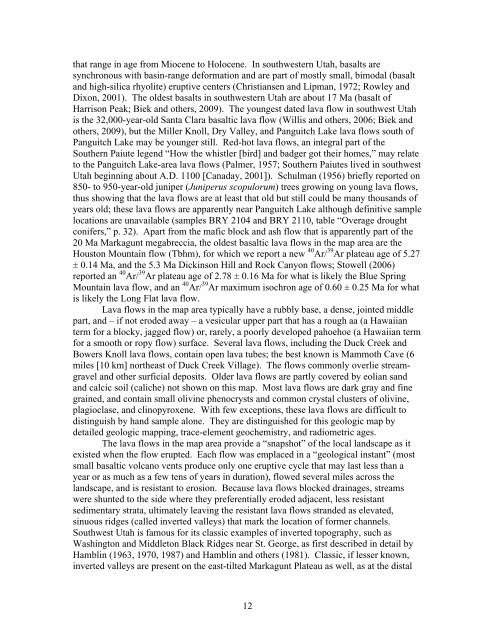Interim Geologic Map of the West Part of - Utah Geological Survey
Interim Geologic Map of the West Part of - Utah Geological Survey
Interim Geologic Map of the West Part of - Utah Geological Survey
You also want an ePaper? Increase the reach of your titles
YUMPU automatically turns print PDFs into web optimized ePapers that Google loves.
that range in age from Miocene to Holocene. In southwestern <strong>Utah</strong>, basalts aresynchronous with basin-range deformation and are part <strong>of</strong> mostly small, bimodal (basaltand high-silica rhyolite) eruptive centers (Christiansen and Lipman, 1972; Rowley andDixon, 2001). The oldest basalts in southwestern <strong>Utah</strong> are about 17 Ma (basalt <strong>of</strong>Harrison Peak; Biek and o<strong>the</strong>rs, 2009). The youngest dated lava flow in southwest <strong>Utah</strong>is <strong>the</strong> 32,000-year-old Santa Clara basaltic lava flow (Willis and o<strong>the</strong>rs, 2006; Biek ando<strong>the</strong>rs, 2009), but <strong>the</strong> Miller Knoll, Dry Valley, and Panguitch Lake lava flows south <strong>of</strong>Panguitch Lake may be younger still. Red-hot lava flows, an integral part <strong>of</strong> <strong>the</strong>Sou<strong>the</strong>rn Paiute legend “How <strong>the</strong> whistler [bird] and badger got <strong>the</strong>ir homes,” may relateto <strong>the</strong> Panguitch Lake-area lava flows (Palmer, 1957; Sou<strong>the</strong>rn Paiutes lived in southwest<strong>Utah</strong> beginning about A.D. 1100 [Canaday, 2001]). Schulman (1956) briefly reported on850- to 950-year-old juniper (Juniperus scopulorum) trees growing on young lava flows,thus showing that <strong>the</strong> lava flows are at least that old but still could be many thousands <strong>of</strong>years old; <strong>the</strong>se lava flows are apparently near Panguitch Lake although definitive samplelocations are unavailable (samples BRY 2104 and BRY 2110, table “Overage droughtconifers,” p. 32). Apart from <strong>the</strong> mafic block and ash flow that is apparently part <strong>of</strong> <strong>the</strong>20 Ma Markagunt megabreccia, <strong>the</strong> oldest basaltic lava flows in <strong>the</strong> map area are <strong>the</strong>Houston Mountain flow (Tbhm), for which we report a new 40 Ar/ 39 Ar plateau age <strong>of</strong> 5.27± 0.14 Ma, and <strong>the</strong> 5.3 Ma Dickinson Hill and Rock Canyon flows; Stowell (2006)reported an 40 Ar/ 39 Ar plateau age <strong>of</strong> 2.78 ± 0.16 Ma for what is likely <strong>the</strong> Blue SpringMountain lava flow, and an 40 Ar/ 39 Ar maximum isochron age <strong>of</strong> 0.60 ± 0.25 Ma for whatis likely <strong>the</strong> Long Flat lava flow.Lava flows in <strong>the</strong> map area typically have a rubbly base, a dense, jointed middlepart, and – if not eroded away – a vesicular upper part that has a rough aa (a Hawaiianterm for a blocky, jagged flow) or, rarely, a poorly developed pahoehoe (a Hawaiian termfor a smooth or ropy flow) surface. Several lava flows, including <strong>the</strong> Duck Creek andBowers Knoll lava flows, contain open lava tubes; <strong>the</strong> best known is Mammoth Cave (6miles [10 km] nor<strong>the</strong>ast <strong>of</strong> Duck Creek Village). The flows commonly overlie streamgraveland o<strong>the</strong>r surficial deposits. Older lava flows are partly covered by eolian sandand calcic soil (caliche) not shown on this map. Most lava flows are dark gray and finegrained, and contain small olivine phenocrysts and common crystal clusters <strong>of</strong> olivine,plagioclase, and clinopyroxene. With few exceptions, <strong>the</strong>se lava flows are difficult todistinguish by hand sample alone. They are distinguished for this geologic map bydetailed geologic mapping, trace-element geochemistry, and radiometric ages.The lava flows in <strong>the</strong> map area provide a “snapshot” <strong>of</strong> <strong>the</strong> local landscape as itexisted when <strong>the</strong> flow erupted. Each flow was emplaced in a “geological instant” (mostsmall basaltic volcano vents produce only one eruptive cycle that may last less than ayear or as much as a few tens <strong>of</strong> years in duration), flowed several miles across <strong>the</strong>landscape, and is resistant to erosion. Because lava flows blocked drainages, streamswere shunted to <strong>the</strong> side where <strong>the</strong>y preferentially eroded adjacent, less resistantsedimentary strata, ultimately leaving <strong>the</strong> resistant lava flows stranded as elevated,sinuous ridges (called inverted valleys) that mark <strong>the</strong> location <strong>of</strong> former channels.Southwest <strong>Utah</strong> is famous for its classic examples <strong>of</strong> inverted topography, such asWashington and Middleton Black Ridges near St. George, as first described in detail byHamblin (1963, 1970, 1987) and Hamblin and o<strong>the</strong>rs (1981). Classic, if lesser known,inverted valleys are present on <strong>the</strong> east-tilted Markagunt Plateau as well, as at <strong>the</strong> distal12
















